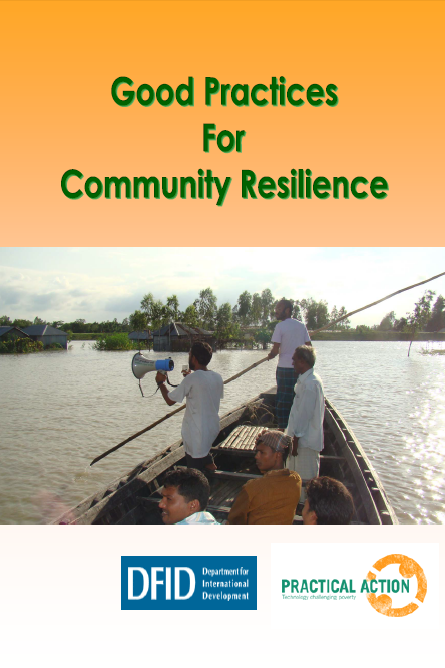
Good Practices For Community Resilience
Foreword
PA Bangladesh has been working on reducing vulnerability particularly to disasters, food insecurity and livelihoods as part of its strategy to reduce poverty in Bangladesh since the last decade. The five year multi country project entitled “Mainstreaming Livelihood-centred Approaches to Disaster Management” funded by the department for International development (DFID) Conflict and Humanitarian fund (CHF). The project is being implemented in Bangladesh, Nepal, Sri Lanka, Zimbabwe and Peru with the active participation of local partners. The project area in Bangladesh includes a total of five Unions of Gaibandha Sadar Upazila (Kamarjani Union) under Gaibangha District, Sariakandi Upazila (Sadar and Narchi Unions) under Bogra District and Kazipur Upazila (Sadar and Maizbari Unions) under Sirajganj District. All three Upazilas are in the floodplain and situated on the western bank of the mighty river Jamuna. The project locations are vulnerable to recurrent river flooding and river erosion. A large number of the population, inhabiting the project location are vulnerable to the repeated (almost every year) and frequent (some times twice in a year) flooding and erosion in addition to their pre-existing economic and social vulnerabilities. The project focuses on two main components; community level activities which reduce the impact of particular hazards by increasing livelihood opportunities, reducing vulnerability and increasing resilience and preparedness; and linking these community-based experiences with local, district and national institutions through advocacy and capacity building in order to influence policy. The project targets several of the Priorities for Action identified in the Hyogo Framework.
The practical application of a livelihoods approach to risk reduction work, while relatively new, can help to identify the extent and nature of the full range of peoples’ livelihood assets and their vulnerability to hazards and other external forces. This makes it possible to identify entry points to protect the assets that are most at risk or most valuable in times of crisis. It gives insights into peoples’ choice of strategies – why they live in fragile and potentially risky situations and how they cope in “normal” circumstances. Activities which strengthen livelihoods and increase resilience will reduce vulnerability.
The project interventions focus on livelihood and preparedness with equal emphasis. In terms of preparedness, the project is mobilizing 6000 house holds in three project locations with active assistance from 300 community volunteers, 300 youth volunteers, CBOs and various committees. Communities were made aware with messages on disasters, impacts and preparedness through these volunteers and committees. Participatory VCA, Contingency Plan has been completed, and a community based disaster management plan is under process. Training on preparedness, search, rescue, evacuation and first aid has been imparted. As part of preparedness, the project facilitated activities like raising homestead, latrine, tube wells above flood levels in a limited scale so other people of the community can emulate these activities as well. Rescue boats for evacuation during flood and river erosion are in place and fully functional.
The purpose behind the livelihoods work to ensure disaster risk reduction with the idea that the beneficiaries will use a part of their earnings for improvement of infrastructure, save money for crisis period, buy food during flood situation when there is no work, will not be dependent on relief (at least if the flood is not prolonged), will not take loan with high interest, will not sell advance labor for survival or sustaining during disaster period. On the other hand these savings or earnings can be used to buy food, and for sending children to school.
This document gives a narrative account of good practices of the project over the period of implementation (January 2006 to December 2008), identifies achievements, successes and lessons learned with respect to increasing the resilience of the communities towards reducing vulnerabilities.
I would like to acknowledge the hard work and contribution made by, firstly the current country program manager Farida Shahnaz,the previous program manager K M Mizanur Rahman and the field staff who include - Senior Project Officers Md. Amzad Hossen, Selim Uddin Ahmed, Md. Zainal Abedien, Barkat Ullah- Coordinator. Special thanks goes to Nasir Uddin Ahmad, Program Assistant for his relentless efforts for compiling the whole document and Pieter Van Den Ende, Project Manager, UK Practical Action for his guidance, editing support and continuous follow up to develop such a quality document. Lastly, I would like to thank the partner organizations for their support in the implementation of the activities and the various other contributions they have made to the project.
Veena Khaleque
Country Director
Practical Action-Bangladesh
Practical Action Bangladesh
House 12/B, Road # 4, Dhanmondi
Dhaka- 1205, Bangladesh
Tel: +880 (0) 2-8650439, 9675236, 9675243
Fax: 8802 9674340
Email:
This email address is being protected from spambots. You need JavaScript enabled to view it.
Editors:
Barkat Ullah
Farida Shahnaz
Pieter Van Den Ende
Published by:
Practical Action-Bangladesh
House # 12/B, Road # 4, Dhanmondi
Dhaka-1205, Bangladesh.
Tel: +88 02 8650439, 9675236, 9675243
Fax: +88 02 9674340
Email:
This email address is being protected from spambots. You need JavaScript enabled to view it.
Web: www.practicalaction.org


































